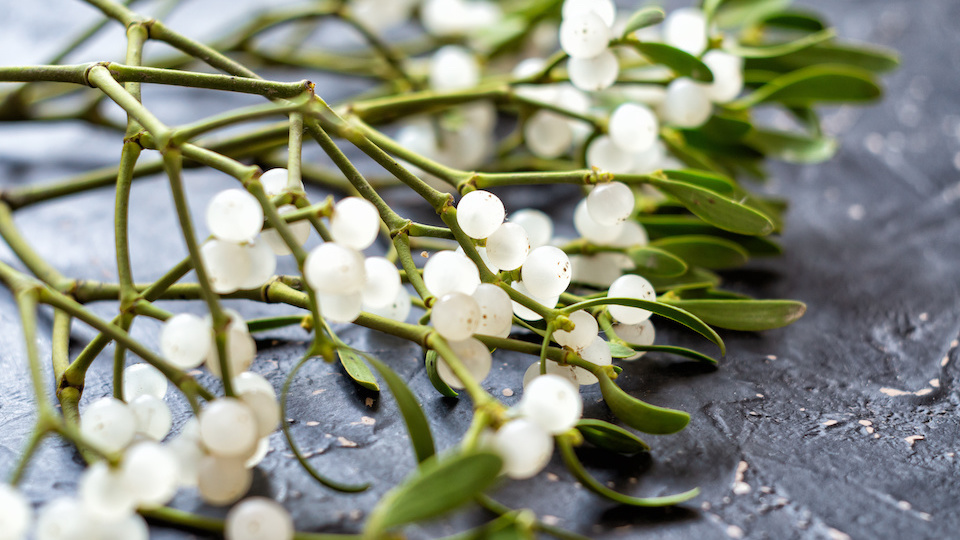Oh, the fun you may have had under the mistletoe! The winter season would not be the same without this inspirational kissing decor. Mistletoe is a beautiful evergreen plant with stunning translucent white berries. Often seen as a symbol of renewal due to its all winter evergreen color, many people don’t know much about this rather interesting plant. Here are some fun facts to ponder.
How mistletoe got its name – The ancient Anglo-Saxons observed that mistletoe often thrives where birds leave droppings. This is how the plant got its name. In Anglo-Saxon, “mistel” means “dung” and” tan” means “twig.” This translates to dung on a twig.
Mistletoe is a parasitic plant – Mistletoe plants grow as parasites on the branches of host trees and shrubs. They may weaken the host plant, but they do not kill it, and the two can coexist well if mistletoe is regularly harvested.
Mistletoe has roots – Once mistletoe lands on a preferred host, it will penetrate roots down into the branch and draw up nutrients and water for survival. These amazing little plants can also produce energy through photosynthesis in their green-colored leaves.
Some mistletoe is endangered – There are more than 20 species of mistletoe that are extinct around the globe.
Mistletoe produces white berries that contain seeds – Mistletoe produces white or almost translucent berries that contain one sticky seed eat. This seed can attach to birds and mammals and be taken on a ride to a new host plant. Dwarf mistletoe, which is native to the western United States and Canada, can explode, sending seeds flying at 60 miles per hour and up to 50 feet.
Mistletoe is a cancer fighter – Extracts from mistletoe are being used in Europe to combat colon cancer. In fact, research in both Europe and America shows that mistletoe may be more effective against cancer and less toxic than chemotherapy.
Many mistletoe species exist – There are about 1,300 types of mistletoe species around the world. In the continental U.S. and Canada, there are over 30 species, while another six are found in Hawaii.
Mature mistletoe resembles baskets – As mistletoe plants grow and mature, they form rounded masses of branches and stems that eventually look like baskets. These baskets are often referred to as “witches brooms.” and can be enormous at 5 feet wide and 50 pounds.
Birds nest in mistletoe baskets – A variety of birds like to nest in the witches’ brooms, such as chickadees, house wrens, mourning doves, and pygmy nuthatches. Additionally, it has been found that 43 percent of spotted owl nests in one forest were associated with witches’ brooms, and 64 percent of all Cooper’s hawk nests in northeastern Oregon were mistletoe. Tree squirrels are also fond of nesting in mistletoe baskets.
Butterflies depend on mistletoe – There are three types of butterflies in the United States that depend on mistletoe for survival. These include the great purple hairstreak, the thicket hairstreak, and the Johnson’s hairstreak. For these butterflies, mistletoe provides a place for them to lay their eggs. Additionally, the adults feed on the nectar from the mistletoe plant.
Mistletoe berries are toxic to humans – The pretty white berries on the mistletoe plant are toxic to humans. However, mammals such as deer, elk, squirrels, chipmunks, and porcupines will turn to the berries for food during the autumn and winter when food is scarce. Birds including bluebirds, mourning doves, robins and chickadees also like the berries.
About the kissing custom – It is thought that the mistletoe kissing custom dates back to at least the 1500’s in Europe. People in early America also recognized this wintertime ritual. Washington Irving made mention of kissing under the mistletoe in “Christmas Eve,” from his 1820 collection of essays and stories. Back in the day, each time a couple smooched under a sprig of mistletoe, they removed one of the berries. Once the berries were gone the kissin’ power stopped.
You can plant mistletoe – If you would like your own collection of mistletoe, you can grow it at home indoors or out as long as you have a suitable host plant. Before you plant, check that mistletoe is not a problem in your area as it can become somewhat invasive.
-Susan Patterson




